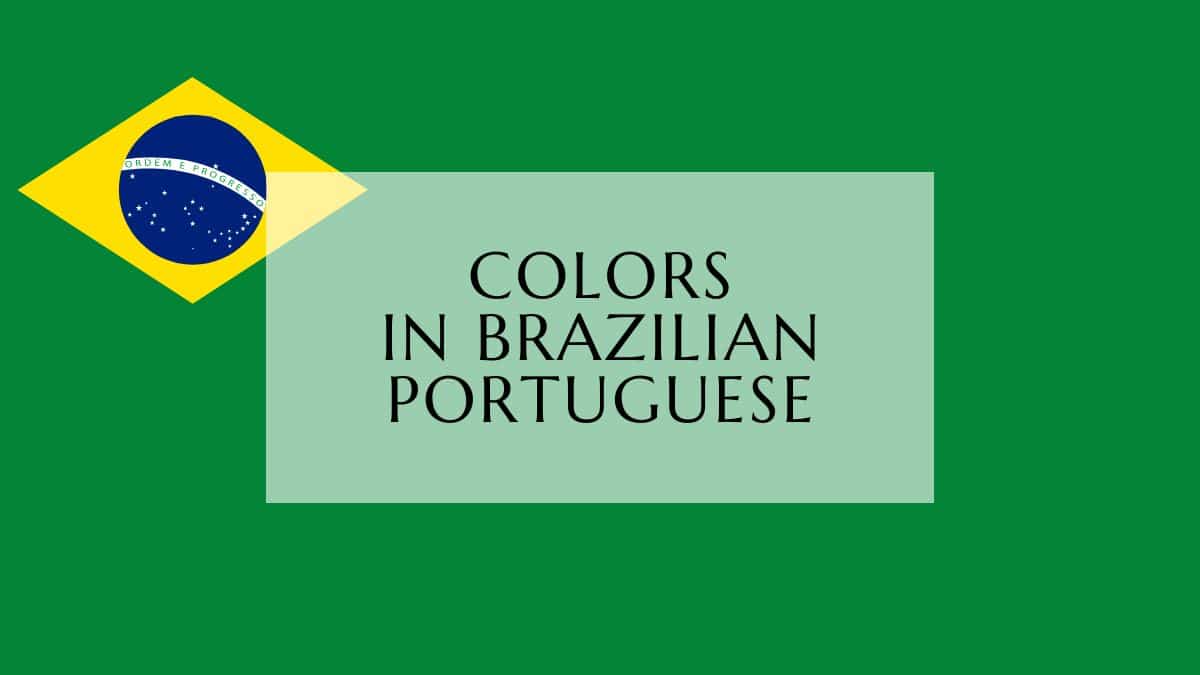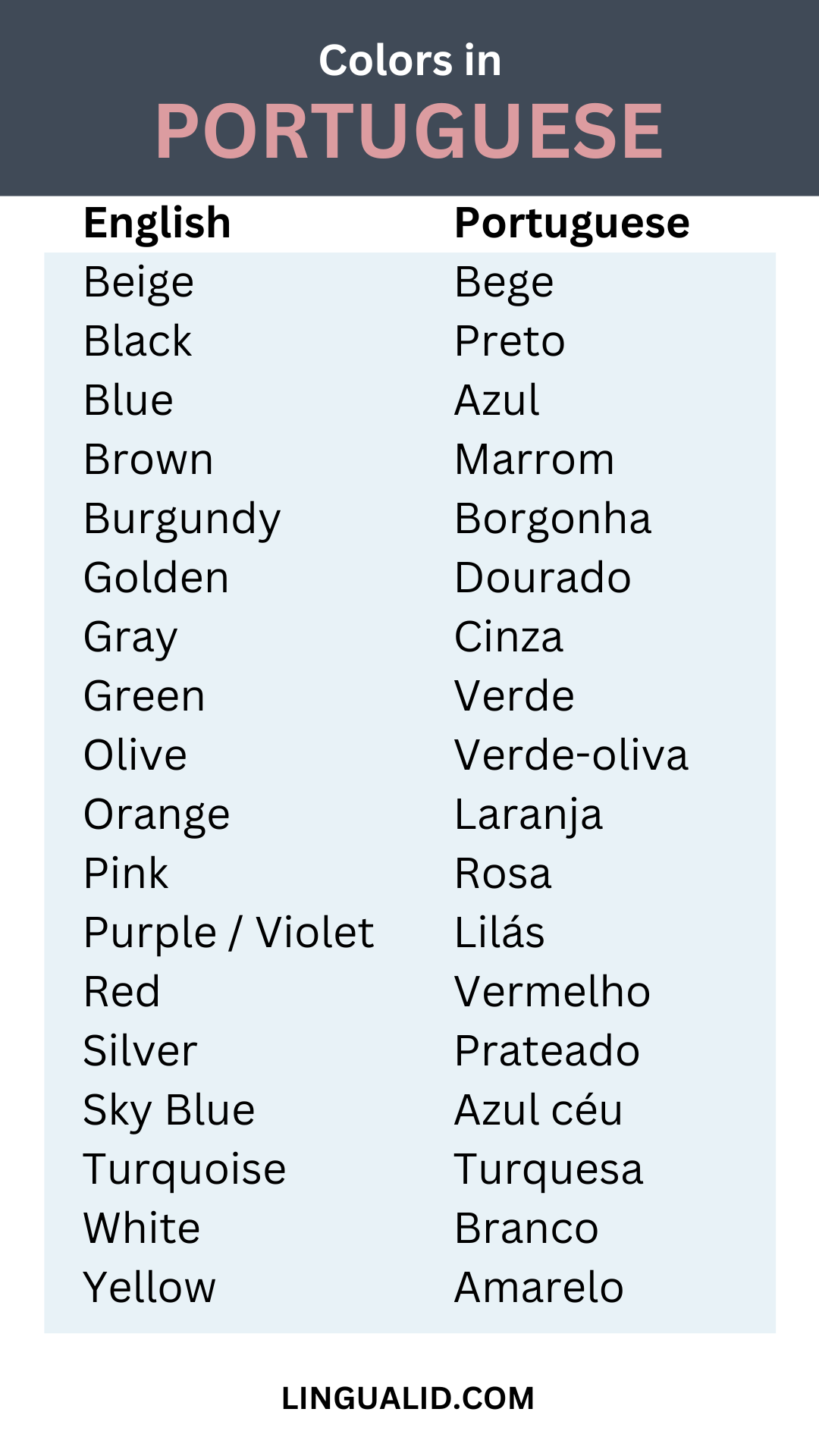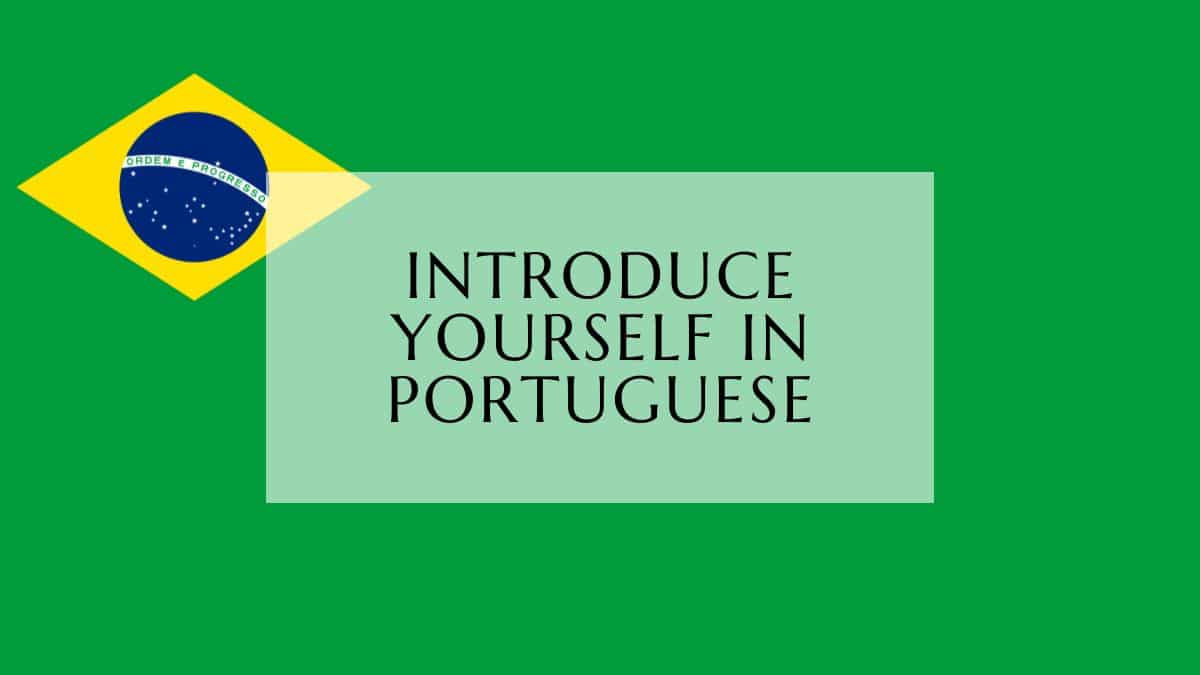Brazilian Portuguese is a language full of vibrant colors. From “vermelho” (red) to “azul” (blue), the spectrum of colors in Brazilian Portuguese is not only diverse but also deeply ingrained in Brazilian culture and everyday communication. Understanding the nuances of color expressions is crucial to fully grasp the meanings behind Brazilian Portuguese idioms, cultural practices, and even everyday conversations. In this comprehensive look at the color spectrum in Brazilian Portuguese, we will explore the meanings, cultural references, and idiomatic expressions associated with each color (with audio so you can learn how to pronounce them). So, let’s dive in and explore the fascinating world of colors in Brazilian Portuguese!

Basic Colors In Brazilian Portuguese
| English | Portuguese |
| Beige | Bege |
| Black | Preto |
| Blue | Azul |
| Brown | Marrom |
| Burgundy | Borgonha |
| Golden | Dourado |
| Gray | Cinza |
| Green | Verde |
| Olive | Verde-oliva |
| Orange | Laranja |
| Pink | Rosa |
| Purple / Violet | Lilás |
| Red | Vermelho |
| Silver | Prateado |
| Sky Blue | Azul céu |
| Turquoise | Turquesa |
| White | Branco |
| Yellow | Amarelo |
Note: you can practice what you’ve learned here, and learn how to pronounce each of the words in our Memrise course here, don’t know how to use the platform or sign up? we’ve got you covered in this easy-to-follow tutorial here.
Shades and tints in Brazilian Portuguese
In addition to basic colors, Brazilian Portuguese also has shades and tints that are used in everyday communication. These shades and tints can be used to describe a variety of objects, from clothing to food to nature.
* Claro – This word is used to describe light or pale colors, such as amarelo claro (light yellow) or verde claro (light green).
* Escuro – This word is used to describe dark or deep colors, such as roxo escuro** (dark purple) or azul escuro (dark blue).
* Vivo – This word is used to describe bright or vivid colors, such as verde vivo (bright green) or rosa vivo (bright pink).
* Opaco – This word is used to describe dull or muted colors, such as verde opaco (dull green) or amarelo opaco (muted yellow).
These shades and tints are important to understand when describing colors in Brazilian Portuguese. They add depth and nuance to conversations and can help to convey emotions and feelings.
Useful vocab:
Cor: Color
Cores: colors
Claro: light
Escuro: dark
Incolor / Transparente: transparent
Cinza escuro: dark gray
Verde claro: light green
Caneta azul: blue pen
Maçã vermelha: red apple
Cadeira marrom: brown chair
Sapatos brancos: white shoes
Color idioms and expressions in Brazilian Portuguese
Colors are also used in idioms and expressions in Brazilian Portuguese. These idioms and expressions are used in everyday communication and are essential to understanding the language and culture of Brazil.
* Verde de inveja – Literally translated as “green with envy,” this expression is used to describe someone who is jealous.
* Azul da cor do mar – This expression, which means “blue the color of the sea,” is used to describe a beautiful shade of blue.
* Vermelho de raiva – Literally translated as “red with anger,” this expression is used to describe someone who is extremely angry.
* Branco no preto – This expression, which means “white on black,” is used to describe something that is clear and easy to understand.
These idioms and expressions are just a few examples of how colors are used in Brazilian Portuguese. They add depth and nuance to conversations and can help to convey emotions and feelings.
Unique color terms in Brazilian Portuguese
Brazilian Portuguese also has a few unique color terms that are not found in other languages. These terms reflect the unique cultural context of Brazil and add depth to the language.
* Roxo-petróleo – This term is used to describe a deep purple color that is associated with the Brazilian semi-precious stone called “ametista.”
* Cor-de-rosa – This term is used to describe the color pink, which is associated with femininity and often used in marketing targeted at women.
* Cinza-chumbo – This term is used to describe a dark grey color that is associated with heavy metals and machinery.
These unique color terms are just a few examples of how Brazilian Portuguese reflects the unique cultural context of Brazil.

From basic colors to unique color terms, colors are essential to understanding the language and culture of Brazil. Whether you are a Portuguese language learner or simply curious about Brazilian culture, understanding the nuances of color expressions in Brazilian Portuguese can provide valuable insights into the colorful world of Brazilian communication. So, go out and explore the fascinating world of colors in Brazilian Portuguese!
Brazilian Portuguese Colors: Study Guide
Quiz
Instructions: Answer each question in 2-3 sentences.
- What two words can you use to create simple color variations in Portuguese, and what do they mean?
- What does “verde de inveja” literally translate to, and what does it mean in casual conversation?
- What color is associated with the expression “azul da cor do mar”?
- How can understanding color idioms enhance your comprehension of Brazilian Portuguese?
- Provide one example of a unique color term in Brazilian Portuguese and explain its cultural significance.
- What word do you use to describe a dull or muted color in Brazilian Portuguese?
- If you want to compliment someone on a vivid shade of green, what term would you use?
- Translate these phrases into Portuguese: a) light blue pen, b) dark brown shoes, c) bright yellow apple.
- The expression “branco no preto” literally translates to “white on black”. What does it mean figuratively?
- What is the significance of understanding color expressions in Brazilian Portuguese beyond just knowing the basic colors?
Quiz Answer Key
- Claro means “light” and escuro means “dark.” These words can be combined with basic color names to create variations, such as “azul claro” (light blue) or “verde escuro” (dark green).
- “Verde de inveja” literally translates to “green with envy.” It is used to describe someone who is jealous.
- “Azul da cor do mar” refers to a beautiful shade of blue, specifically the color of the sea.
- Color idioms provide insights into cultural expressions and add depth to your understanding of the language beyond literal meanings. They are commonly used in everyday conversations.
- “Roxo-petróleo” is a unique color term that describes a deep purple, specifically the color of the Brazilian semi-precious stone called “ametista.”
- The word opaco is used to describe a dull or muted color.
- You would use the term verde vivo to compliment someone on a vivid shade of green.
- a) Caneta azul clara, b) Sapatos marrom escuro, c) Maçã amarelo vivo.
- Figuratively, “branco no preto” means something that is very clear and easy to understand.
- Understanding color expressions provides insight into Brazilian culture, idioms, and the nuances of everyday communication, enhancing overall language comprehension.
Glossary of Key Terms
- Claro: Light, pale
- Escuro: Dark, deep
- Vivo: Bright, vivid
- Opaco: Dull, muted
- Verde de inveja: Green with envy (jealous)
- Azul da cor do mar: Blue the color of the sea
- Vermelho de raiva: Red with anger
- Branco no preto: White on black (clear, easy to understand)
- Roxo-petróleo: Deep purple color of the amethyst stone
- Cor-de-rosa: The color pink
- Cinza-chumbo: Dark grey color associated with metal and machinery
Happy learning!
Oualid Cheddadi is the founder of Lingualid, a platform that inspires independent language learners worldwide, regardless of the language they are learning. The name “Lingualid” is derived from the Portuguese word for “language,” “língua,” and the last three letters of Oualid’s name, “Lid.”



